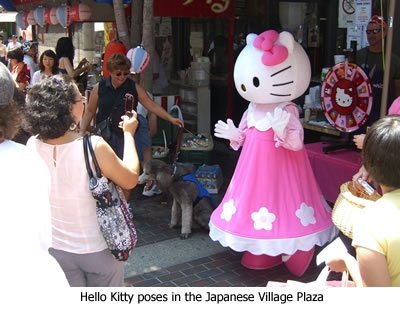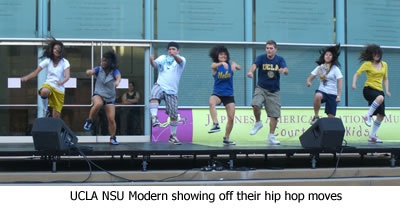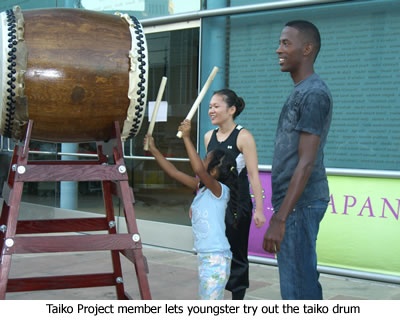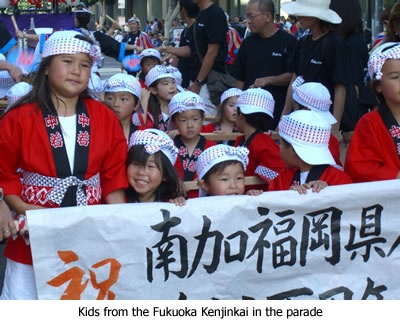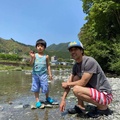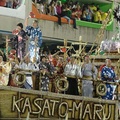Saturday, August 16
On Saturday morning I arrived early at the Japanese American National Museum. Yonezawa-san was already there. He is the president of the Miyagi Kenjinkai. Miyagi Prefecture is famous throughout Japan for the Tanabata Festival in Sendai. On the seventh day of the seventh month, the streets of Sendai are lined with colorful decorations called fukinagashi. Yonezawa-san and the Miyagi Kenjinkai made five fukinagashi that we were going to use to decorate the central hall of the museum. The Kenjinkai boss was especially excited to share a part of his culture with the Nisei Week festival-goers.
Four of the decorations were placed inside the central hall where family-oriented activities were scheduled to take place later in the day. But fukinagashi really need to be outside where the wind can blow through the long trailing streamers; it almost appears like they are dancing in the sky. So we saved one, the most colorful one, to place just outside the museum entrance. Yonezawa-san proudly took a picture in front of the fukinagashi; he was smiling like a little kid. Next year, with a little planning, I think we can decorate the entire front of the Japanese American National Museum with colorful streamers, now wouldn’t that be something to see!
I walked around Little Tokyo to check out some of the Nisei Week activities. The Japanese Village Plaza was busy with people, mostly non-JAs. They were exploring the shops and places to eat. Some musicians were getting ready to play on the stage in front of Nijiya. Hello Kitty was there too taking pictures with all the happy kids. I got a free Hello Kitty fan from the new Sanrio store to give to my co-worker later.
I went to the JACCC Plaza next. There was a crowd of people watching a sumo demonstration under a big tent. I checked the schedule and most of the stage events were martial arts and taiko demonstrations. Inside the JACCC building they exhibited ikebana and other Japanese cultural arts. This year they didn’t have any food booths or the beer tent in the plaza.
I moved on to the street fair on San Pedro Street. I was hoping to find something good to eat. In past years, the booths stretched the entire length of the block. I was disappointed to see that it was only half as long this year. And with no Tofu Festival this year—after a 12-year run, the Tofu Festival served it’s last dish in 2007—the crowd was noticeably smaller. I walked around. There were some game booths, community service organizations tables, vendors selling t-shirts and a small selection of food. But nothing really made my mouth water. I saw the shave ice, but where was the takoyaki?
I spoke a little with the people at the bone marrow match booth. It turns out Asians in need of a bone marrow transplant have a greater chance of matching with other Asians. The odds of a life saved increases if we can get more Asians to sign up for this program. If you haven’t registered yet, please go and do it. (www.asianmarrow.org)
I also chatted with the guys from the ImaginAsian Center. If you haven’t heard of it, the ImaginAsian Center is a new movie theater that replaced the Linda Lea Theater that a long time ago used to show samurai flicks to Little Tokyo’s residents. Part of the reason for opening the theater was to get more people to come to downtown and enjoy what Little Tokyo has to offer. Sadly, that hasn’t been the case as attendance has been less than expected.
By the time I got back to the museum, the family activities were going full steam. The central hall was full of kids making origami, kites and other craft projects. Author Naomi Hirahara was there to read from her new children’s book, 1001 Cranes. It’s the story of a young girl discovering a connection with her Nisei grandparents. In the late afternoon, everyone moved outside for free live entertainment. First up was Magic Andrew, then some hula dancing, followed by a hip-hop performance by Nikkei students from UCLA and for the finale, an amazing concert by Taiko Project.
I enjoyed my first day at the festival but was disheartened by the small size of the crowd and lack of booths and food. This year’s Cherry Blossom Festival had more booths than Nisei Week. But adding more things to see and food to eat isn’t going to solve the problem of lack of interest in Nisei Week alone. The Tofu Festival was a great idea that brought in a larger crowd, but the loss of space due to the construction of a new residential building and the fact that the event grew too big for the organizers made it unsustainable. This is a complex issue, but clearly, unless a clear, new direction is taken, the Nisei Week Festival will continue to wither away with an inevitable end.
Sunday, August 17
I arrived in Little Tokyo wearing a traditional Japanese light cotton jacket and pants set called a jinbei. When I lived in Japan as an English teacher, I enjoyed many Japanese festivals and a big part of their celebrations is dressing the part. Women wear a brightly-colored summer kimono called a yukata. There are yukata for men too, but I only have a jinbei that was given to me as a present in Japan. I think it would be great if more people dressed up for Nisei Week, but that tradition has been lost to Sansei and Yonsei.
I brought a friend who was visiting from Japan. She wore a light blue yukata with yellow flowers. I gave her a tour of the Japanese American National Museum. She was not familiar with the story of the Issei and Nisei during World War II and so it was a nice learning experience for her.
We walked around Little Tokyo and watched a group of cosplay kids put on a little show. Cosplay is where hardcore fans wear costumes of their favorite anime characters. Cosplayers are addicted to anything Japanese, a result of watching hundreds of hours of Japanese animation, and so they come out to Little Tokyo to buy Japanese candy or comics from Kinokuniya bookstore and hang out with their cosplay friends.
I ran into the Japanese group that carries the mikoshi (portable shrine) in the parade every year. The mikoshi is an integral part of many Japanese festivals. This mikoshi was a gift of Yokaichi City to their sister city, Long Beach. I actually joined the team in carrying the mikoshi the last two years, but this year since I had a guest I could only say “gomen nasai!” The mikoshi is heavy and they need every back they can get to carry it along the parade route.
I told my friend about peanut butter mochi and took her to Mikawaya to see if she wanted to try one. They don’t make peanut butter mochi in Japan. In fact, she found the concept strange and turned down my offer. It’s funny how some Japanese people don’t like peanut butter just like how some American people don’t like azuki beans. I guess that’s what’s cool about being Japanese American, we get the best of both worlds.
The parade started at five in the afternoon. Thankfully, this year there was a nice breeze blowing through Little Tokyo and it was not as hot as past years. My Japanese friend enjoyed watching the parade, as it was her first time. For me, a parade is really a spectator event. I like to participate, not watch from the side. I guess that’s why I joined the mikoshi team.
One of the best things about the Nisei Week parade is the diversity of the performances. When I was younger, I used to think that all the dancers were the same. But the participating groups represent different parts of Japan and they bring with them unique dance styles, music and costumes. It is like watching many festivals in one. One of my favorites was the Fukuoka Kenjinkai. They had a group of kids pulling a taiko drum and the man playing the drum had great energy. Watch the video and see for yourself:
http://www.youtube.com/watch?v=5MLmdwtnQkg
My friend was getting tired—wearing an obi around the waist all day can wear you out—and so we weren’t able to stay until the end to see the Nisei Week Queen and the mikoshi team. But I’m really glad that she came out and enjoyed herself. The best thing about Nisei Week for me this year was being able to share it with someone who has never been to Little Tokyo before.
One last thing… At the street fair I overheard one young man—he was Asian and looked like he was in his mid-20s—he asked, “Where were all the fun things to do?” And he honestly looked disappointed. When I look at old photos of Nisei Week from the 50s and 60s, it looked like a real festival. When Little Tokyo declined in the 70s, Nisei Week suffered as well. The crowds became smaller, the fun disappeared.
To me, festival is about spirit—the spirit of the community, of the people. Where did the spirit of the Nikkei community go? If we want to save Little Tokyo and Nisei Week, we have to find ways to energize the community and create active participation. Let’s identify our traditions and encourage their practice. It could be as simple as dressing up for Nisei Week and decorating the streets to make it look like a festival. Let’s get the Japanese community more involved, some of the best festivals I’ve been to have been in Japan, they really know how to do it right. Let’s get families involved so that traditions are passed on to their children. Let’s make Nisei Week fun again.
I also have to credit the Nisei Week organizers. I think they do the best they can with what little they have to work with. The fact that we still even have a Nisei Week is a testament to their commitment to the community. So we have one year to go until the next Nisei Week, show your spirit and get involved!
© 2008 Bobby Okinaka



